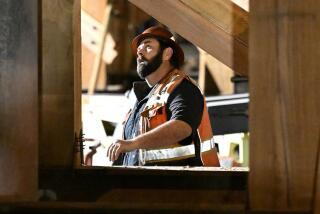U.S. Manufacturing Slows Again; Housing Still Strong
- Share via
U.S. manufacturing stumbled in February after a strong start to the year, a survey showed Monday, suggesting that a sustained recovery in economic growth and employment remains uncertain at best.
Still, there was bright news on the housing market, where a building boom is in full swing, but even that was balanced by a surprising drop in personal consumption in January, other reports showed.
“The economy is standing on only one leg -- housing,” said Ethan Harris, co-chief economist at Lehman Bros. “It’s not the most stable of platforms to be building growth from.”
Unease in manufacturing grew in the Institute for Supply Management’s survey of purchasing managers. Its main business index slipped to 50.5 in February from 53.9 in January, well below market forecasts of 52.4 and only just above the 50 barrier that separates growth from contraction.
Alarming for an already depressed jobs outlook, the ISM’s employment index slumped to 42.8 from 47.6, its lowest reading in a year and a grim omen for the February payrolls report due Friday.
“No one is hiring.... I would not be surprised at all to see another fall in payrolls,” said Ram Bhagavatula, chief economist at Royal Bank of Scotland Financial Markets.
Analysts have been looking for payrolls to rise a tiny 8,000 in February after January’s 143,000 bounce, but that forecast could turn negative.
Much of the deterioration in the overall ISM survey was due to a relatively large 7-point slide in new orders to 52.3, a jarring development because orders are considered a leading indicator of production. “The threat of war is dampening demand and that applies to every industry,” said Norbert Ore, chairman of the ISM manufacturing business survey committee. Ore also singled out higher energy prices, which are squeezing demand and profit margins.
Other figures had mixed implications for growth. Personal consumption fell 0.1% in January, versus forecasts of a 0.1% rise, while income rose 0.3%, against estimates of a 0.4% gain.
Analysts said real consumption, adjusted for inflation, fell a steeper 0.3%, largely because of the slump in demand for autos, and that suggested spending made a smaller contribution to GDP in January than first thought.
Indeed, the weak result caused some analysts to shave their forecasts for consumption and GDP growth this quarter. Estimates are still fluid, but most are crowded in the 2% to 3% area, compared with an annualized 1.4% rise in GDP in the last three months of 2002.
Still, the softness was balanced in part by another spectacular performance from the home building industry, where residential spending jumped 2.5% to a record high in January, courtesy of low mortgage rates. That compensated for a depressed office and industrial sector and lifted overall construction spending by 1.7%, well above economists’ forecasts.
Home prices rose 6.9% during the fourth quarter of 2002 from the same period in 2001, the Office of Federal Housing Enterprise Oversight reported.
More to Read
Inside the business of entertainment
The Wide Shot brings you news, analysis and insights on everything from streaming wars to production — and what it all means for the future.
You may occasionally receive promotional content from the Los Angeles Times.










